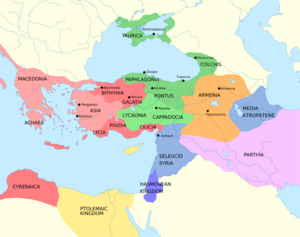Asiatic Vespers facts for kids
Quick facts for kids Asiatic Vespers |
|
|---|---|
| Part of the First Mithridatic War | |

Asia Minor and surrounding region at the start of the First Mithridatic War, in 89 BC
|
|
| Location | Asia Minor |
| Date | c. early 88 BC |
|
Attack type
|
Mass murder and Genocide |
| Deaths | 80,000–150,000 |
| Victims | Romans and Latin-speaking peoples |
| Perpetrators | Mithridates VI Eupator |
| Motive | Purge Asia Minor of Roman influence |
The Asiatic Vespers (also known as the Asian Vespers or Ephesian Vespers) was a terrible event that happened around 88 BC in a part of the world called Asia Minor (which is now modern-day Turkey). During this time, thousands of Romans and other people who spoke Latin were killed. These killings were ordered by Mithridates VI Eupator, the powerful ruler of the Kingdom of Pontus.
Mithridates wanted to remove all Roman influence from Asia Minor. He believed the Romans were taking over too much. This event is estimated to have caused the deaths of 80,000 to 150,000 people. It was a major reason why the First Mithridatic War began between the Roman Republic and the Kingdom of Pontus.
Contents
Why the Massacre Happened
Rising Tensions Between Rome and Pontus
For many years, Mithridates, the king of Pontus, tried to avoid fighting with the Roman Republic. Rome was busy with its own wars, like the Jugurthine and Cimbric wars. But Mithridates started taking control of more lands around the Black Sea, which made Rome pay attention to him.
Around 108–107 BC, Mithridates and another king, Nicomedes III of Bithynia, secretly agreed to divide a region called Paphlagonia. Rome found out and told them to stop, but they ignored Rome's warning.
Disputes Over Neighboring Kingdoms
A few years later, around 102 BC, Mithridates and Nicomedes argued over another kingdom called Cappadocia. Nicomedes sent soldiers there and married the queen. Mithridates tried to kill the king of Cappadocia, Ariarathes VII Philometor. When that didn't work, Ariarathes went to war.
Mithridates invaded with a large army and killed Ariarathes. He then put his own son, Ariarathes IX, in charge around 101 BC. Mithridates tried to get Rome to accept his new conquests, but Rome wasn't happy.
Later, after Mithridates' son was removed from power, Nicomedes asked Rome for help. Rome decided that both kings should leave Cappadocia. Rome then sent a general, Lucius Cornelius Sulla, to help the people of Cappadocia choose a new king, Ariobarzanes I.
Rome's Distraction and Mithridates' Opportunity
Rome soon became busy with a big conflict called the Social War. Mithridates saw this as his chance. He teamed up with Tigranes I, the king of Armenia.
When Nicomedes III died and his son Nicomedes IV became king, Mithridates and Tigranes removed Ariobarzanes from Cappadocia. They also forced Nicomedes IV out of Bithynia.
When Rome heard about this, they ordered that both kings be put back on their thrones. Rome sent a leader named Manius Aquillius to make sure this happened. Mithridates agreed to Rome's demands and even had his own puppet king of Bithynia killed.
The Spark of War
However, the kings of Cappadocia and Bithynia now owed Rome money for helping them. Since they couldn't find the money, Rome encouraged them to invade Pontus, Mithridates' kingdom. This was a huge mistake by Rome.
Mithridates reacted by invading Cappadocia and Bithynia. Manius Aquillius tried to gather soldiers, but Mithridates defeated him. By the middle of 89 BC, Mithridates had won against four allied armies and taken control of most of Roman Asia. He celebrated his victory by removing all taxes for five years and appointing his own leaders in the conquered lands.
News of Mithridates' victories reached Rome in late 89 BC. Even though Rome was still fighting the Social War, they immediately declared war on Mithridates. However, it took them a long time to gather their forces. The Roman leader Lucius Cornelius Sulla was given command against Mithridates, and it took him about 18 months to get his army ready.
The Massacre Itself
Mithridates' Plan
The massacres were a planned response to Rome declaring war. Mithridates wanted to force the cities in Asia Minor to choose a side. If a city followed his orders to kill Romans, it could never go back to being loyal to Rome.
The killings likely happened in the first half of 88 BC. Reports suggest that around 80,000 people were killed, though some sources claim up to 150,000. These numbers might be exaggerated, but the event was still a huge tragedy.
Mithridates secretly sent letters to local leaders. He told them to kill all Italian residents, including their wives, children, and freed slaves of Italian birth, 30 days after receiving the letter.
Incentives for Participation
Mithridates offered rewards to encourage people to participate. He promised freedom to slaves who reported their Italian masters. He also offered to cancel the debts of anyone who killed their creditors (people they owed money to). Those who helped with the killings would also share half of the victims' property with the Pontic treasury.
Many cities became scenes of these terrible acts, including Ephesus, Pergamon, Adramyttion, Caunus, Tralles, Nysa, and the island of Chios. Many of these cities were controlled by rulers who supported Mithridates. Many local people eagerly attacked their Italian neighbors. They blamed the Romans for problems like greed and unfair lawsuits.
When Did the Massacre Happen?
Historians still debate the exact date of the massacre. Some place it in late 89 BC or early 88 BC. Others say it happened in the first half of 88 BC.
The name "Vespers" was first used in 1890 by a historian named Théodore Reinach. He compared it to another historical event called the Sicilian Vespers of 1282. Since then, historians have used "Vespers" as a polite way to refer to this terrible massacre.
See Also

